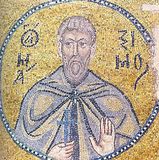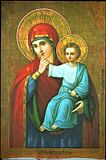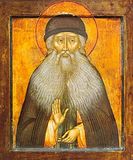

| Previous day | Next day |
| Old Style
January 21
|
Friday |
New Style
February 3
|
|
34th Week after Pentecost.
Tone 8.
Fast Day. |
Fish, wine and oil allowed.
|
![]() St. Maximus the Confessor (662).
St. Maximus the Confessor (662). ![]() Martyr Neophytus of Nicaea (303-305).
Martyr Neophytus of Nicaea (303-305). ![]() Martyrs Eugene, Candidus, Valerian, and Aquila, at Trebizond (3rd c.-4th c.).
Martyrs Eugene, Candidus, Valerian, and Aquila, at Trebizond (3rd c.-4th c.). ![]() St. Maximus the Greek, monk, of Russia (1556).
St. Maximus the Greek, monk, of Russia (1556).
Virgin-martyr Agnes of Rome (ca. 305). Martyr Anastasius, disciple of St. Maximus the Confessor (662). St. Timon, monk, of Nadeyev and Kostroma (1840).
“Paramythia” Icon of the Most Holy Theotokos (807), at Vatopedi (Mt. Athos).
Hieromartyrs Fructuosus, bishop of Catalan (Spain), and with him deacons Augurius and Eulogius (259). St. Zosimas, bishop of Syracuse (662). Synaxis of the Church of Holy Peace by the Sea, Constantinople. St. Callistratus, catholicos-patriarch of Georgia (1952).
Thoughts for Each Day of the Year
According to the Daily Church Readings from the Word of God
By St. Theophan the Recluse

Monday (33rd). [I Pet. 2:21–3:9; Mark 12:13–17]
The Apostle now points out to us the hidden man of the heart (I Pet. 3:4) as the object of our most careful concern and care. We are to adorn ourselves through the formation of this man within ourselves. What is this hidden man of the heart? It is that man which forms in the heart when only good dispositions and feelings come to dwell therein. Examine these dispositions and feelings, and you will see the face of the man hidden in the heart. Here are those dispositions! As His divine power hath given unto us all things that pertain unto life and godliness (II Pet. 1:3), and on your part, giving all diligence, writes Saint Peter, add to your faith virtue; and to virtue knowledge; and to knowledge temperance; and to temperance patience; and to patience godliness; and to godliness brotherly kindness; and to brotherly kindness love (II Pet. 1:5–7). In a similar fashion Saint Paul lists the inner good dispositions of the Christian heart: The fruit of the Spirit is love, joy, peace, longsuffering, gentleness, goodness, faith, meekness, temperance (Gal. 5:22–23). Also: Put on therefore, as the elect of God, holy and beloved, bowels of mercies, kindness, humbleness of mind, meekness, longsuffering ... and above all these things put on love, which is the bond of perfectness. And let the peace of God rule in your hearts (Col. 3:12–15). Bring together all of these goods into one spiritual body with its various members, and you will see the divinely beautiful face of the hidden man of the heart. You must fervently establish the same in your own heart.
Friday. [II Pet. 1:1–10; Mark 13:1–8]
Having enumerated the virtues which we must seek with all diligence, having received grace-filled power, the Apostle says by way of encouragement, If these things be in you, and abound, they make you that ye shall neither be barren nor unfruitful in the knowledge of our Lord Jesus Christ (II Pet. 1:8). The virtues to which he refers here were mentioned in I Pet. 2:21–3:9. Now we shall add only that we are required to manifest these virtues not just once, but rather to make them always abide in us, to be part of our essence, to take root in us. Thus, they must not remain on one level, but ever multiply and grow in strength and fruitfulness. Only then, he says, will you not be barren and unfruitful in the knowledge of our Lord Jesus Christ (II Pet. 1:8). He who believes in Him and confesses Him enters into the knowledge of the Lord. “You believe?” says the Apostle! See then, that your faith be not barren and unfruitful. What should I do, so that my faith will not be that way? Prosper in every virtue. Where are those who repeat over and over that believing is enough: that nothing more is needed?! Whoever thinks this way is blind.
Articles
 St. Maximus the ConfessorSaint Maximus the Confessor was born in Constantinople around 580 and raised in a pious Christian family. |
 Martyr Neophytus of NiceaThe Holy Martyr Neophytus, a native of the city of Nicea in Bithynia, was raised by his parents in strict Christian piety. |
 Virginmartyr Agnes of RomeWhen she refused to enter into marriage with the son of the city official Symphronius, one of his associates revealed to him that Agnes was a Christian. |
 Icon of the Mother of God “Comfort” or “Consolation”The Vatopedi “Comfort” or “Consolation” Icon of the Mother of God is in the old Vatopedi monastery on Athos, in the church of the Annunciation. |
 The “Otrada”—Consolation IconThe Icon known as the “Otrada”, or ‘Consolation”, icon is in the Vatopedi Monastery on Mt. Athos, which had been established during the reign of Constantine the Great. |
 St. Fructuosis of Tarragona, SpainSaint Fructuosis lived during the persecution of Valerian and Gallienus in the third century, during the consulship of Amelianus and Bassus. |







